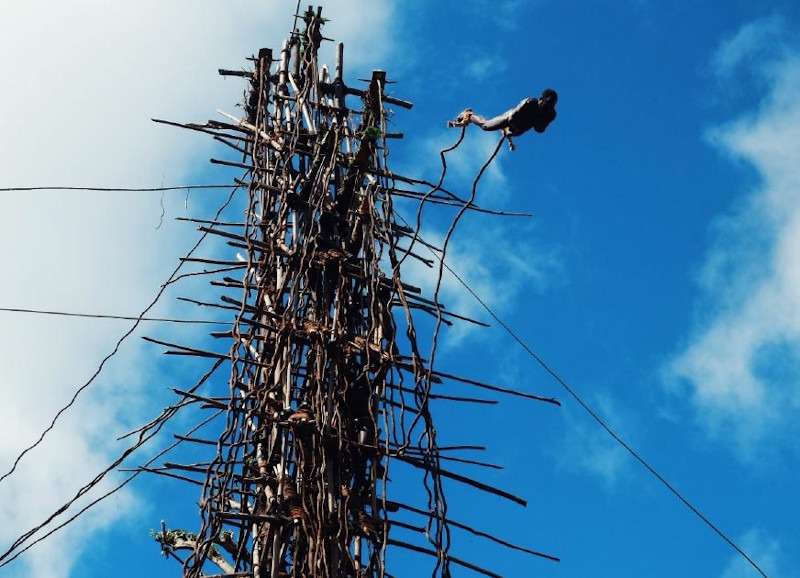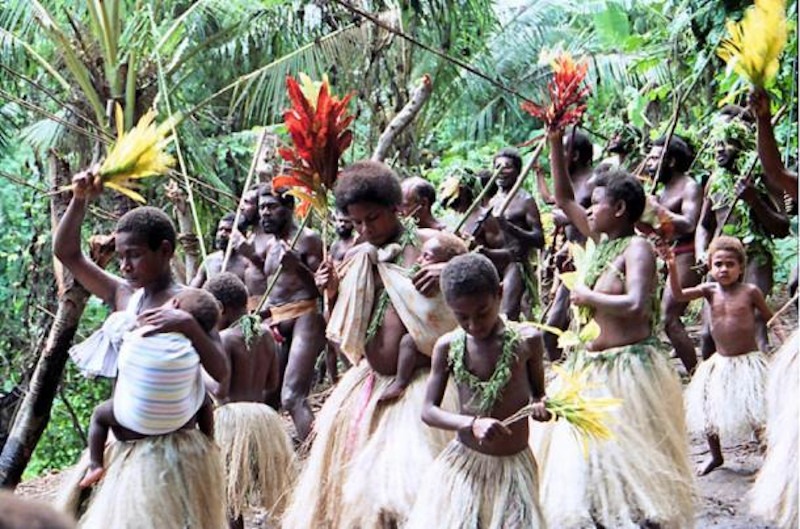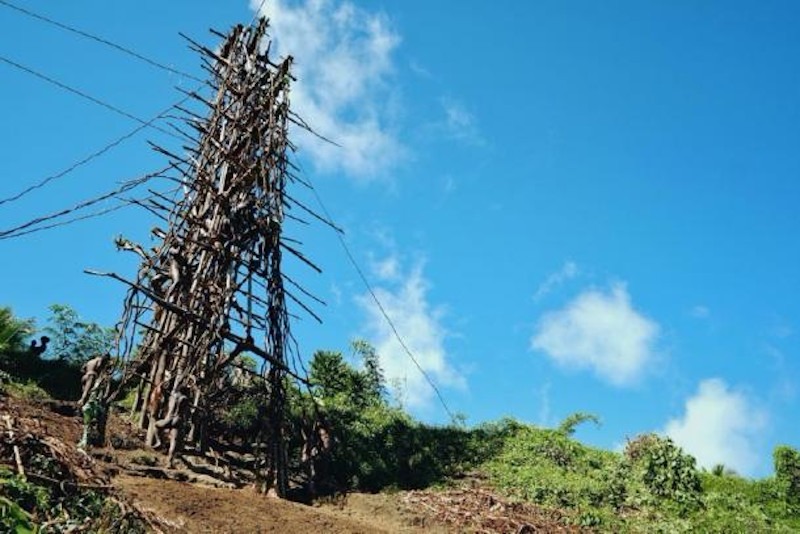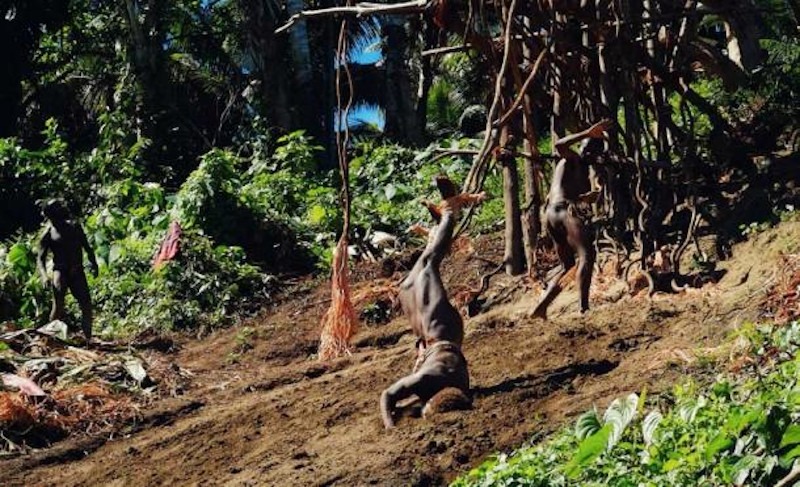
Richard Butler | Exclusive By Aleksa Vuckovic of Ancient Origins | December 30th, 2019
Throughout the history of the world, tribal and slightly primitive people of remote corners of the globe, have always had unique beliefs and traditions. From Papua New Guinea, to Australia to the Pacific island nations, each separate tribe has a different view on the world around them. To all of them, the most important traditions have been the rites of passage, for example, the coming of age for young boys as they transition into men and become a full-fledged part of the tribe. Plenty of traditions are also focused on the yearly harvest. But in Vanuatu, a South Pacific island nation, these traditions and rites of passage have a unique and dangerous form. Join us as we explore the tribal predecessor of bungee jumping, a death-defying ritual of the natives of Pentecost Island, Vanuatu. Take the leap with us!
Ancient Courage – Land Diving Explained
This widely attested ritual is exclusive to the Pentecost Island, one of the 83 islands that comprise the nation of Vanuatu. It is performed by men of all ages, both teenage boys, and adult men. This unique rite is not only considered a rite of passage for young men, but it is also an important ceremony that is performed before the yam harvest. It is mostly observed in the southern part of the island, where it is called Nanggol in the Bislama language, and Gol in the Sa Language. The ritual culminates with the diving, where young men compete in defying death as they plunge headfirst from rickety wooden towers. The towers are around 100 feet tall (30 meters) and have multiple levels. Therefore, younger boys are not made to jump from the tallest ones.

The jumpers wear nothing but their nambas, traditional penis sheaths. They also have specially chosen tree vines ( lianas) tied around their ankles. As they plummet down towards the ground, the men can reach up to speeds of 45 miles per hour (75 kilometers per hour). No safety equipment exists amongst these tribal islanders, the men only rely on their bravery and the elasticity of the vines. To make it more dangerous, at the bottom there are no air bags, no cushions and in general, nothing to soften the fall at all. Instead, there is the soil, and the men must touch it with their shoulders. This ritual is considered as a blessing to the soil. The men simply cross their arms across their chest, tilt their head forward and hope for the best, as they violently scrape the soil with their backs.

According to modern sources, this tradition is the precursor to the bungee jumping sport. But while bungee jumping is considered a good choice for a quick adrenaline rush, the Pentecost Island ritual is far from it. It has a complex ritual significance. Firstly, it is only performed in April, May, or June, coinciding with the yam harvest. The islanders believe that a high and successful jump will ensure a rich harvest. It should be noted that yam is the most important food for the islanders.
On the other hand, the ritual is an expression of masculinity. It is undertaken by the bwahri, the warriors, who attempt to show their courage by jumping from the high towers. Younger boys will jump from lower levels, thus earning their place amongst men, which is seen as an important rite of passage.
Pentecost islanders believe that the towers are home to a spirit, or some sort of deity, named Tamalie. The legend says that long ago Tamalie was a man, who often abused and beat his wife. In despair, she fled from him, climbing to the top of a tall tree. Tamalie sought and found her, climbing after her in a frenzy. But the woman tied tree vines around her ankles and leaped down to the ground. Tamalie wrongly believed that she had committed suicide, and filled with despair, he too jumped down, but instead without the tree vines and as result, he died. This belief remains in the society, and nowadays, women are not allowed to go near the wooden towers. If they do, it is believed that Tamalie will be angered and claim a man’s life because of it. In addition, women are strictly prohibited from observing any of the preparations and rituals leading to the jumps. However, women do perform choreographed dances, sing and bolster the jumpers, and therefore, they are part of the land diving ceremony in some way.

Archaic Rituals in a New World
Nagol is the tall wooden tower, and it is the central feature of the entire ritual. It is constructed from tree trunks, branches and vines. The building process lasts from two to four weeks, with twenty men tasked with the construction. Even the building of the tower has significance, and the builders undergo ritual purification before they start. For example, they remove themselves from society and abstain from sex for a period of time.
The land diving is also filled with various rituals. Those who have chosen to jump must first settle all their affairs as there is a chance that they might die. Additionally, the night before the event, they sleep curled around the base of the tower. This is because the towers are seen as guardians that keep the bad spirits at bay. When morning comes, they receive a ceremonial wash, then anoint their bodies with coconut oil and decorate themselves with boar tusks.

The Nagol Tower
When the land diving begins, it follows a gradual pattern. The youngest jumpers are the first to go as this is their rite of passage. It is a chance to show to their social circle that they are courageous and a worthy mate. The age and height of the competitors gradually increase, and the whole event culminates when the bravest men leap from the highest point.
This is in no way a mundane ritual. It is rife with dangers, injuries, and even deaths, which have happened on several occasions. Perhaps the most infamous of these documented deaths occurred in 1974, during the visit of Queen Elizabeth II of the United Kingdom . Even though it was out of season, a land diving ritual was held in her honor. But this is was what made it so tragic. The vines were not in season, and thus not elastic enough. They snapped, sending a jumper straight to the ground, where he died before the Queen and all onlookers.

That is why the season in which the ritual is performed is so important. During yam harvest time between April and June, the tree vines are most elastic. Out of season, the vines are likely to be too old and too dry, which can result in the death of the jumpers.
From Land Diving to Bungee Jumping
A certain New Zealander, named A. J. Hackett, visited the Pentecost Island in 1986. He witnessed the land diving ritual, which inspired him to modernize it and turn it into an attraction. He began experimenting with modern equipment and materials, including a lot of climbing gear. After perfecting his design, which only took him a year, he made the first ever “bungee” jump in 1987. He leapt from the top of the Eiffel Tower with success, and from that point on, bungee jumping became a popular international attraction, giving rise to thrill seekers across the world.
Hackett’s modernized version of the ancient tribal ritual remained exclusive only to the world outside the Pentecost island. The islanders refused to modernize their authentic ritual jumping and continued to do it their own way without safety equipment, harnesses or cushions. Even though Vanuatu is no longer a wholly primitive cluster of islands, the islanders remain true to their own ways. Towers are still rickety, shaky, and constructed without modern tools. Age-old rituals are still performed, dances danced, and songs chanted, which is all in the hope that a high jump will give a plentiful harvest of yam.

The world does not heed the will of nations to live in peace. Vanuatu’s Pentecost Island and its unique traditions have reached the eyes of the world, and ever since, thousands of tourists have been flocking to the island in hopes of witnessing this death-defying ritual. The commercialization, and to an extent, the exploitation of this tribe and its customs have been criticized by many officials. It shows us that the modern age doesn’t care for tribes still living their own lives in ancient ways. The world dictates: “You MUST become modern!” However, the tribal elders of Pentecost Island do not shun onlookers. This is because the revenue from the tourism essentially allows their tradition to survive. For how long this is the case, we shall see.
Fighting to Preserve Their Identity
The money that the tourism brings in is a powerful weapon. Soon after Vanuatu was placed on tourist maps, the land diving ritual began “migrating” from its place of origin, the Pentecost Island, to the other neighboring islands of the Vanuatu archipelago. It was first performed for tourists on the islands of Efate and Santo. However, it was never originally performed on other islands, and it has always been native exclusively to the south of Pentecost. In 1990, as a part of the filming of the movie called Till There Was You , a land diving ritual was supposed to be filmed on Efate Island. Controversy arose, and the tribal chiefs that formed the Pentecost Island Council, heavily opposed this, claiming that the ritual was a custom unique to their island. They argued that exporting it elsewhere would diminish its value and threaten the identity of the Pentecost island natives.
More controversy occurred when the ritual was to be performed in Luganville. Again, the tribal chiefs gathered and opposed it, but not only those from Pentecost. Chiefs from the islands of Santo (on which Luganville is) and Malo, opposed the ritual, claiming it invaded their own islands, and it inhibited them from performing their own customs and traditions, thus earning their own revenue from tourism.
As a result of this tourist commercialization, measures to protect the custom are still being undertaken. To prevent any possible exploitation, the presentations are all held by the tribal chiefs. They fight to preserve the authenticity of the ritual amongst the populace, and to make sure it is not just performed for the sake of tourists.
Today, tourists that want to watch the ritual take place must pay around $100 to $120. Furthermore, commercial filming of the jumps has been banned by the Vanuatu Cultural Centre, in hopes of further preserving this tradition.

In the north of the Pentecost Island, a movement was formed by the indigenous people to prevent the spread of modern Western economy to the islands, and instead to fight for the preservation of their traditional native customs. The movement is called the Turaga Nation, and it seeks to re-establish the native system of economy, which is based on exchange and traditional currency forms, such as pigs and woven materials. They now have their own bank, the Tangbunia, and a unit of currency, livatu, which is worth as much as a fully carved boar’s tusk. The movement is fighting for the preservation of the traditions of Pentecost islanders and the rest of the Vanuatu natives, and through them, the land diving ritual can survive in its pure and ancient form.
In 1970, a white man was given the privilege to be a part of the land diving ritual, and he jumped alongside Pentecost Island men. This was Kal Müller, a journalist who spent two years with the natives of the island before they finally accepted him enough to allow him to jump in the ritual. After preparations, he jumped with success, and wrote of his experiences in the National Geographic magazine.
True to Themselves
The Pacific island nations are certainly filled with various tribes, each one having a different language, unique traditions, and age-old customs that have survive to this very day. They serve as a unique window into the past, into the development of Polynesian and Melanesian cultures, and into the history of these islands, which are still forming their identity in this modern world.
It remains to be seen whether we allow them to become just another tourist attraction, losing their identity in the process, or we fight to protect their tradition and allow them to remain who they truly are.
